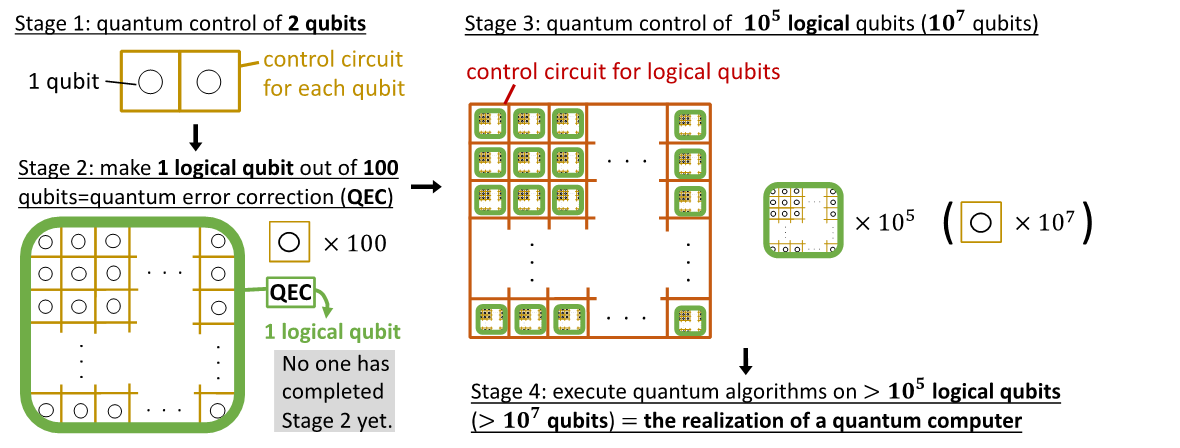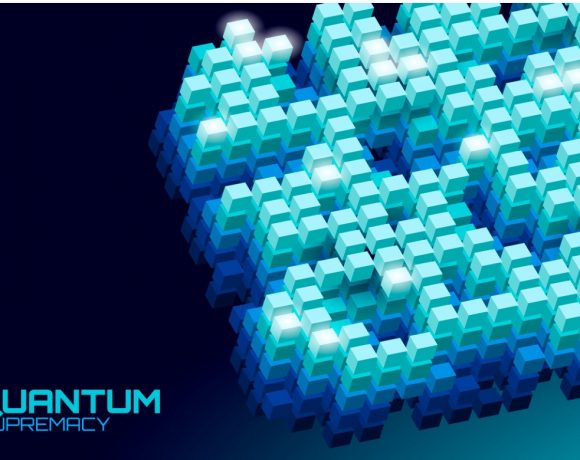- Once a quantum computer is realised, we will be able to perform large-scale simulations to solve problems that cannot be tackled with classical computers.
- If we divide the road toward the realisation of a quantum computer into four stages, the inevitable conclusion is that even with the most-advanced qubits—superconducting qubits—we have only completed Stage 1 so far.
- In order to realise a quantum computer with processing power surpassing that of a classical computer, more than 100,000 logical qubits are required; thus, more than 10,000,000 qubits are required.
- In order to circumvent the limitation in completing the later stages, Floating-Electron-Based Quantum Information RIKEN Hakubi Research Team at RIKEN in Japan and their collaborators have proposed using electrons on helium as qubits. This is a relatively new physical system to realise qubits with and there are only a few other laboratories in the world working on the application of electrons on helium to quantum computation.
The inventions of letterpress printing, computers, and the internet dramatically changed the way we deal with information and enriched our lives. Quantum computers may be the next technology to join this list.
A quantum computer works based on a different concept from a classical computer: using the quantumness (quantum superposition state and quantum entangled state) of quantum binary bits (qubits). Once a quantum computer is realised, we will be able to perform large-scale simulations to solve problems that cannot be tackled with classical computers [Nielsen, Quantum Computation and Quantum Information (Cambridge University Press, 2011)]. Moreover, we will achieve perfectly secure cryptography against hackers (quantum cryptography). Recently an increasing number of IT companies (Google, IBM, Intel, etc.) have started to get involved in research on quantum computation, and it may seem that quantum computers will become available very soon. However, suppose we divide the road toward the realisation of a quantum computer into four stages. In that case, the inevitable conclusion is that even with the most-advanced qubits—superconducting qubits—we have only completed Stage 1 so far (Fig. 1). Even though we expect that superconducting qubits will attain Stage 2 soon, achieving the later stages will not be straightforward. In Stage 1, the most fundamental qubit controls are physically realised. In Stage 2, to overcome the qubits’ vulnerability, a logical qubit is composed of 100 physical qubits. In Stage 3, the qubit controls are realised for 100,000 logical qubits (i.e. 10,000,000 physical qubits). Finally, in Stage 4, we can execute quantum algorithms.

Fig. 1. Stages to be achieved to realise a quantum computer based on [Jones, Phys. Rev. X 2, 031007 (2012)]. We must achieve the early stages before moving on to the later stages. More than 10,000,000 qubits will be required to realise a quantum computer.
What obstacles hinder us from completing the later stages? The major challenge is the need to prepare a large number of qubits. We need to correct errors caused by the loss of quantumness. Using a quantum error correction technique (QEC), by making one logical qubit out of ≈100 qubits, the error can become so low that calculation results become reliable. In order to realise a quantum computer with processing power surpassing that of a classical computer, more than 100,000 logical qubits are required; thus, more than 10,000,000 qubits are required [Phys. Rev. A 86, 032324 (2012)]. However, placing such a huge number of superconducting qubits in one experimental setup called a cryogenic refrigerator is difficult because the space consumed by one superconducting qubit is huge, and the space inside one cryogenic refrigerator is limited.
In order to circumvent this limitation, Floating-Electron-Based Quantum Information RIKEN Hakubi Research Team at RIKEN in Japan and their collaborators have proposed using electrons on helium as qubits. This is a relatively new physical system to realise qubits with, and there are only a few other laboratories in the world working on the application of electrons on helium to quantum computation. The size of these qubits is small, and the team envisages that they will be able to align 10,000,000 qubits two-dimensionally to attain Stage 3. The downside of this system is the difficulty of detecting qubits. Control circuits are composed of circuits for detecting qubits (the detection circuit) and manipulating qubits (the manipulation circuit).
In the absence of a detection circuit, we cannot even begin to work on Stage 1. This is the reason why not even Stage 1 has been achieved for electrons on helium. In order to overcome this problem, the team recently developed a new technique that will allow us to make a detection circuit of electrons on helium: image-charge detection [Phys. Rev. Lett. 123, 086801 (2019)]. Thanks to this progress, we now have all the components needed to start working on Stage 1. Within a couple of years, the team hopes to complete Stage 1. Even if the electrons on the helium system is currently behind superconducting qubits for their application to quantum computation, after the team completes Stage 1, they feel that electrons on helium are a more promising road to attain Stage 3.
The application of electrons floating on liquid helium has a high potential for providing an ideal platform on which to realise a quantum computer due to the fact that it is free of impurities and defects. Electrons on helium are expected to become a new qubit that will dramatically enhance the performance of quantum computers.






NO COMMENT